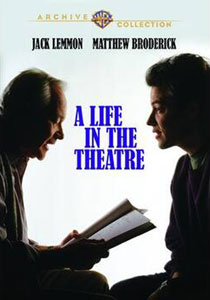Like he would later do for Hollywood with “State and Main” (2000), writer David Mamet lovingly pokes fun at the art of the stage in “A Life in the Theatre,” a 1993 TNT movie based on his 1977 play. Jack Lemmon is magnetic as Robert, an aging community theater thespian, and Matthew Broderick is mostly a sounding board as the up-and-coming John, who is starting to get calls to work in film.
But the movie goes on some insider tangents and gets stuck in a cycle of showing a botched theater moment followed by Robert’s humorously juxtaposed wise (or “wise”) pontifications, so it’s ultimately a middling trifle compared to other Mamet works.
Mosher avoids claustrophobia
Director Gregory Mosher and his team nicely open up the play for this 78-minute film, with scenes in the dressing room and restaurants and Robert’s apartment and sometimes even outdoors. (The 1979 PBS movie, which has been lost to history, was simply a recording of a stage production starring Peter Evans and Ellis Rabb.)

“A Life in the Theatre” (1993)
Director: Gregory Mosher
Writer: David Mamet
Stars: Matthew Broderick, Nicole Bukky, Jack Lemmon
Naturally, there are scenes in a theater, too, including several where the seats are empty. Anyone who even kind of likes theater will likely feel something nostalgic looking at those rows of seats – rows of possibility receding to the back – like Robert does.
Mamet captures that specific brand of BS that comes from certain actors, and if Robert and John can’t keep up their patter for the full run time, well, that’s reminiscent of this type of community theater actor holding court. Early on, though, it’s amusing to hear the duo exchange analyses of their respective performances but gradually give in to their insecurities when a slightly less-than-glowing comment is offered.
The humor of “A Life in the Theatre” tends to be tame and smile-worthy, with Mamet’s go-to gag being scenes that go wrong – albeit always in a new way. A chair collapses; or Robert grabs the phone before the ring sound effect; or John enters a scene too soon; or the actors disagree on which line is next, but try to remain in character.
Lemmon’s latest sad sack
Lemmon gives a sad-sack turn that made me wish I was watching him in “Glengarry Glen Ross” (1992), where he gets much meatier material. One thing Lemmon fails at is convincing a viewer that he’s a mere community theater actor; Broderick fits better in this regard.
(On the other hand, perhaps it’s a comment on the brutal nature of this business that Robert has to take gigs as an Easter bunny. Or perhaps he has no day job and pieces together a meager income as an actor.)
As a climax to the story, Robert’s depression – hinted at throughout the film, or perhaps natural to Lemmon’s late-career style — comes to the forefront, an appropriate note for a film that somewhat strangely leans toward melancholy. One scene finds Robert running lines in his apartment for an invisible co-star; in another, he does a scene at a diner. People stare at him, but don’t react. He’s a star in his own mind, but he hasn’t convinced even his own mind.

Mamet captures the essence of the theater, warts and all, but he is hesitant to make many strong statements or stage wild gags – something he’d get over when it came time to send up the inner workings of cinema in “State and Main.” And I personally think even that film is a trifle, so that should give you an idea of how low-key “A Life in the Theatre” is.

